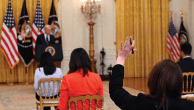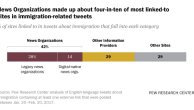Summary of Findings

As the first vials of swine flu vaccine make their way into American communities, public interest in news about the disease is increasing. Nearly as many people now cite swine flu as their top news story of the week as mention the health care debate – the first time in several months that reports on health care have not clearly led the public’s news agenda.
Close to four-in-ten Americans (38%) say they are following news about the swine flu and vaccine very closely, the highest percentage tracking the issue very closely since spring. In early May, 43% said they were following news about the swine flu very closely.

The latest weekly News Interest Index survey, conducted October 9-12 among 1,003 adults by the Pew Research Center for the People & the Press, finds that fewer than half (46%) say news reports are presenting the swine flu’s danger about right, while nearly as many (43%) say news reports are overstating the danger; just 7% say the press is understating the potential threat from the swine flu. More than half of Republicans (54%) say news reports are overstating the swine flu’s danger, compared with 42% of independents and just 35% of Democrats.
Half of those younger than 40 think the press is overstating the danger, a view shared with 43% of those 40 to 64 and just 29% of those 65 and older. College graduates are more likely to say the dangers are overstated (51%) than are those with less education (39% of those with some college experience, 40% of those with a high school degree or less).

Overall, fewer than half of Americans (47%) say that they would get the swine flu vaccine if it was available to them; an identical percentage says they would not get the vaccine. A clear majority of Democrats (60%) say they would get the swine flu vaccine if it was available, compared with 41% of Republicans and the same percentage of independents.
Despite the public’s reservations over the vaccine, most Americans continue to express confidence in the government’s ability to deal with the swine flu. Currently, 64% say they are very (17%) or somewhat (47%) confident in the government’s ability to deal with the swine flu, which is virtually unchanged from late August (65% at least somewhat confident). Three-quarters of Democrats (75%) and 62% of independents express confidence in the government to handle this issue, compared with 51% of Republicans.
Why Not Get the Vaccine?

Those who say they would not get the swine flu vaccine point to a variety of reasons for their decision, including personal factors. But the most frequently mentioned reason – cited by 35% – is that the swine flu vaccine is too risky or that it has not been thoroughly tested.
Nearly a quarter (23%) say that they are healthy and do not get the flu, or that they simply avoid getting shots. And 16% express a more general skepticism about vaccinations or say that flu shots in general get them sick
One-in-ten (10%) of those who say they would not get the vaccine say that the risk of swine flu has been exaggerated. A comparable percentage (9%) – including a relatively large proportion of those 65 and older – say that they are not in a high-risk group, or that they want to save the vaccine for at-risk people.
Health Care, Swine Flu Top Stories
A quarter of Americans (25%) followed news about the health care debate more closely than any other news story this week, while about as many (24%) cited reports about the swine flu and the vaccine as their top story. This marks the first time since mid-July that health care reform has not clearly been the public’s top story. At that time, the death of Michael Jackson was the most closely followed story.
The public is evenly divided over the prospects for congressional passage of health care reform legislation over the next year: 46% say a health are reform bill will not pass, while 45% say it will pass. A majority of Democrats (56%) expect a bill to pass, compared with 47% of independents and 28% of Republicans.

In terms of news coverage for the week, the U.S. military effort in Afghanistan was the top story, accounting of 20% of all coverage, according to separate analysis by the Project for Excellence in Journalism (PEJ). By contrast, 10% of coverage was devoted to the health care debate and 5% for swine flu during the week of Oct. 5-11, according to PEJ.
Only about one-in-ten Americans (11%) cited news about Afghanistan as their top story, which trailed mentions of the economy (16%) as well as swine flu and the health care debate. However, public interest in the U.S. military effort in Afghanistan has increased in recent weeks. Currently, 31% say they are tracking Afghanistan news very closely, the highest percentage this year.
Interest in economic news has remained fairly steady in recent weeks, and most Americans (66%) continue to say that they are hearing a mix of both good and bad news about the economy; 27% say they are hearing mostly bad economic news while just 6% say they are hearing mostly good news. Views of economic news are little changed from early September.
In other news, Barack Obama winning the Nobel Peace Prize was the top story for 9% of the public; less than quarter (23%) tracked this story very closely. Nearly twice as many Democrats (30%) as Republicans (17%) followed news about Obama’s surprise Nobel victory very closely.
These findings are based on the most recent installment of the weekly News Interest Index, an ongoing project of the Pew Research Center for the People & the Press. The index, building on the Center’s longstanding research into public attentiveness to major news stories, examines news interest as it relates to the news media’s coverage. The weekly survey is conducted in conjunction with The Project for Excellence in Journalism’s News Coverage Index, which monitors the news reported by major newspaper, television, radio and online news outlets on an ongoing basis. In the most recent week, data relating to news coverage were collected from October 5-11, 2009 and survey data measuring public interest in the top news stories of the week were collected October 9-12, 2009 from a nationally representative sample of 1,003 adults.
About the News Interest Index
The News Interest Index is a weekly survey conducted by the Pew Research Center for the People & the Press aimed at gauging the public’s interest in and reaction to major news events.
This project has been undertaken in conjunction with the Project for Excellence in Journalism’s News Coverage Index, an ongoing content analysis of the news. The News Coverage Index catalogues the news from top news organizations across five major sectors of the media: newspapers, network television, cable television, radio and the internet. Each week (from Monday through Sunday) PEJ compiles this data to identify the top stories for the week. The News Interest Index survey collects data from Friday through Monday to gauge public interest in the most covered stories of the week.
Results for the weekly surveys are based on landline telephone interviews among a nationwide sample of approximately 1,000 adults, 18 years of age or older, conducted under the direction of ORC (Opinion Research Corporation). For results based on the total sample, one can say with 95% confidence that the error attributable to sampling is plus or minus 3.5 percentage points.
In addition to sampling error, one should bear in mind that question wording and practical difficulties in conducting surveys can introduce error or bias into the findings of opinion polls, and that results based on subgroups will have larger margins of error.
For more information about the Project for Excellence in Journalism’s News Coverage Index, go to www.pewresearch.org/pewresearch-org/journalism.




